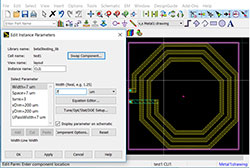Modern wireless communications systems are based on an ever-expanding array of standards and boast new and sophisticated functionality. This serves to complicate an already challenging design and test process. Keysight Technologies’ Advanced Design System (ADS) software has been used by RF and microwave designers to solve the most demanding problems. Its latest release, ADS 2017, introduces pioneering solutions, a host of new 3D capabilities and enhanced performance in circuit, electromagnetic (EM) and electro-thermal simulation to help designers meet the stringent requirements of modern wireless communications design.

Figure 1 Editable 3D layout of an LNA.
Optimized 3D Design—The increased complexity of today’s wireless designs demands improved solutions for viewing and editing. With the new 3D capabilities in ADS2017, it is now possible to visualize and edit a printed circuit board (PCB) or MMIC/RFIC layout in three dimensions (see Figure 1). This provides a powerful tool for verifying that designs meet requirements and helping to find mistakes. ADS 2017’s new 3D capabilities also simplify stitching with vias in a multi-layered design, routing in dense areas and making complex structure selections while preparing for EM simulation.

Figure 2 Multi-technology electro-thermal simulation for a flip-chipped and packaged PA, showing the package cross-section (a), PA die (b) and 3D thermal profile (c).
Enhanced 3D Electro-Thermal Simulation—To avoid costly circuit revisions with power amplifier (PA) modules requiring high density layouts or employing advanced processes (e.g., GaN and GaAs), designers must assess the thermal performance of the circuit prior to tape out. The ADS electro-thermal simulator provides designers with a full 3D thermal solver tightly integrated with the ADS layout environment and circuit simulators. It computes the full system or chip temperature profile and annotates this information in the circuit simulator for temperature-accurate circuit analysis. ADS 2017 takes these capabilities one step further by allowing multiple technologies to be thermally simulated together.

Figure 3 3D Smith chart showing EVM surface versus the load impedance for a PA.
As an example, consider a PA design flip-chipped and encapsulated in a QFN package. The design includes the die, laminate, copper bumps and packaging, which creates a highly variable thermal resistance profile that is difficult to analyze. Figure 2 shows the multi-technology substrate setup inside ADS 2017 and the thermal analysis of the entire 3D chip, with excellent resolution and accuracy. With this information, designers can make necessary edits and tape out with a high degree of confidence.
Simplified 3D Data Visualization—ADS 2017 offers designers a simple way to process ADS simulation results using Python. The capability unleashes new functionality to analyze, manipulate and visualize ADS results and is available to expert Python users, as well as those with no previous experience. For non-programmers, Keysight provides workspaces containing Python scripts. One example application with downloadable code is the creation of 3D Smith charts, a graphical aid that helps visualize large amounts of information using a single plot. For instance, a 3D Smith Chart can plot how impedance changes versus frequency, voltage or other variables, so designers can make informed decisions on tradeoffs among these parameters (see Figure 3).

Figure 4 FEM-generated EM waves for a chip package and bond wires (a) and PCB with board interconnects (b).
Powerful 3D EM Simulation—The 3D finite element method (FEM) engine in ADS is a full-wave EM simulator that is used to analyze 3D EM effects in the frequency domain. It is especially useful simulating the EM effects of components, such as high speed and RFIC packages, bond wires, antennas, on- and off-chip embedded passives and PCB interconnects. The FEM engine is fully integrated inside both ADS and Keysight’s 3D modeling and simulation environment, EMPro. Exporting and importing designs to and from the engine is automated to save time and minimize errors, compared to manually exporting and importing.
With the release of ADS 2017 and EMPro 2017, the FEM engine is more powerful (see Figure 4). A smarter mesh creator, adaptive meshing algorithm, use of mixed-order functions and parallel frequency point solving allow the FEM in ADS 2017 to run an average of 1.5 to 2x faster than its predecessor. Also, disk space usage is reduced by approximately 50 percent. This makes the FEM engine more accessible to RF and microwave designers.

Figure 5 CoilSys automates PCell construction so RFIC designers can create DRC-clean PCells.
3D Via Designer—Via models that are accurate at high frequencies is a crucial problem when simulating high speed signal interconnects. To solve this, ADS 2017 introduces Via Designer, a tool for creating and modeling single-ended or differential PCB vias, giving the designer full control over the via’s parameters. Via Designer uses FEM to fully characterize the EM effects of the model, ensuring high frequency accuracy. It supports parametrized sweeps, enabling fine tuning of the circuit during full-channel simulation. With this new tool, the uncertainty associated with via design is eliminated.
Automated PCell Construction—Abundant and capable simulation options and integration with Keysight’s GoldenGate software, the “gold standard” in RFIC simulation, make ADS an excellent platform for starting and completing silicon RFIC designs. ADS 2017 further complements this functionality with the addition of CoilSys, an add-on utility that automates PCell construction for spiral inductors (single-ended or differential), transformers, baluns, solenoids and transmission lines (see Figure 5). The resulting PCells are design rule checking (DRC) clean and ready to utilize in an RFIC design. CoilSys eliminates the manual creation of layout cells, often a laborious task and not an efficient use of the RFIC designer’s time. The layouts created with CoilSys are EM simulated and can be parametrized for component synthesis, as well as design optimization.
Stronger and More Comprehensive Simulation—In the wireless communications system design environment, where the slightest edge can mean the difference between design success or failure, the powerful and comprehensive new features in ADS 2017 may be just the tool today’s designers need to get ahead.
Keysight Technologies Inc.
Santa Rosa, Calif.
www.keysight.com

